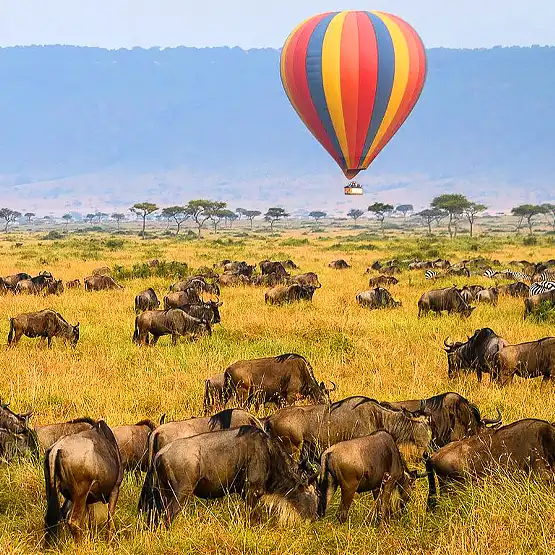Ever wondered what it’s like to live as humanity’s ancestors once did? During a Hadzabe Bushmen experience, you step into the lives of one of the world’s last remaining hunter-gatherer tribes. You’ll immerse yourself in their daily routines, from hunting with handcrafted bows to gathering wild fruits and honey.
The Hadzabe tribe’s way of life offers a fascinating glimpse into human history, unchanged for thousands of years. Did you know that their population is estimated to be just around 1,300 people today? By engaging with them, you not only witness ancient traditions but also contribute to the preservation of their unique cultural heritage.
What to Expect During a Hadzabe Bushmen Experience
During a Hadzabe Bushmen experience, you will meet a remarkable tribe living in northern Tanzania. Their lifestyle has remained largely unchanged for thousands of years. You will have the chance to observe their traditional ways of hunting and gathering. This is not just a history lesson but an immersive adventure. The Hadzabe’s connection to nature is truly fascinating.
One of the most exciting parts of the experience is participating in a traditional hunt. The Hadzabe hunt using handmade bows and arrows, tracking animals like their ancestors did. You might also gather wild berries or roots. It’s an active and engaging way to learn about their unique skills and survival techniques. According to this post, these activities offer a real connection to their culture.
Another highlight is learning the Hadzabe language, which has distinctive click sounds. Understanding their communication methods gives deeper insight into their culture. You can even engage in simple conversations with tribe members. They are friendly and open to sharing their stories. This makes the experience even more meaningful.
Finally, you’ll get to see how the Hadzabe cook their food using simple, natural methods. Their diet mainly consists of hunted meat, fruits, and honey. You might even try some of their traditional dishes. This hands-on experience offers a full sensory immersion. For more details, you can check out more about their lifestyle here.
Meet the Hadzabe Bushmen of Tanzania
The Hadzabe Bushmen of Tanzania are one of the last remaining hunter-gatherer tribes in the world. Living near Lake Eyasi, their lifestyle is a time capsule of human history. The tribe has fewer than 1,500 members, making their culture incredibly unique and fragile. They sustain themselves through hunting, using handmade bows and arrows. Their profound knowledge of local plants and animals is essential for survival.
Spending time with the Hadzabe gives you a glimpse into their daily life. The men typically hunt early in the morning while women gather fruits, roots, and honey. This division of labor has existed for generations. You’ll see their simple yet effective tools. It’s a testament to their ingenuity and deep connection with nature.
Language is another fascinating aspect of the Hadzabe culture. They speak Hadzane, which features distinctive click sounds. Learning a few words can be an exciting challenge. This unique dialect is part of what makes their culture so intriguing. It’s also an excellent way to bond with tribe members.
Visitors have the chance to participate in traditional dances. These dances are not just performances but are tied to their spiritual beliefs and rituals. Here, you can see the tribe’s rich cultural heritage in action. Witnessing these traditions is a highlight for many visitors. Their vibrant, rhythmic movements tell stories of their ancestral past.
Participate in Traditional Hunting and Gathering
Joining the Hadzabe Bushmen in their traditional hunting and gathering activities is an exhilarating experience. You’ll set out early in the morning with the men of the tribe, who will teach you how to use handmade bows and arrows. Tracking animals through the bush, you learn their expert techniques for a successful hunt. Every step immerses you deeper into their age-old practices. This hands-on involvement makes the experience both educational and thrilling.
Gathering is equally fascinating, especially with the knowledge shared by the Hadzabe women. You will learn to identify edible fruits, roots, and honey, ensuring nothing poisonous is picked. Interaction with the children might even reveal their unique way of climbing trees to collect honey from beehives. The experience showcases their resourcefulness and the cooperation needed to thrive. It’s a remarkable display of teamwork and survival skills.
These activities are not only about survival but also community bonding. While hunting or foraging, the Hadzabe share stories and songs, adding a cultural layer to the experience. It’s a way of passing down traditions and knowledge. Observing and participating in these exchanges gives deeper insight into their close-knit society. The camaraderie among the tribe members is palpable and heartwarming.
Though challenging, the physical aspect of these activities brings you closer to understanding their way of life. You might cover vast distances on foot, navigating through dense vegetation and rough terrain. But every bit of effort enhances your appreciation of the Hadzabe’s daily struggles to secure food. This active participation is a powerful reminder of human connection to nature. The entire process is a lesson in sustainability and respect for the environment.
Learn the Hadzabe Language and Communication Methods
The Hadzabe language, Hadzane, is one of the most fascinating aspects of the tribe’s culture. It features unique clicking sounds that are rare in modern languages. The clicks are not just for show; they play an essential role in communication. Learning these sounds can be challenging but rewarding. There’s something intriguing about mastering the clicks and understanding their meanings.
Visitors often start with basic words and phrases, getting familiar with the language’s rhythm. The Hadzabe are generally patient and eager to teach. They might begin with common greetings or names of local plants and animals. You’ll quickly notice how language is woven into their daily activities. Each word often carries a deep connection to their environment.
Engaging in conversations with tribe members is a fantastic way to learn more about Hadzane. This interaction allows for a more immersive experience. The tribe shares stories, songs, and jokes, which are perfect opportunities to practice the language. It’s quite special when you can understand and participate in their traditional tales. It’s not just words; it’s a gateway into their world.
Learning Hadzane also strengthens the bond between visitors and the Hadzabe. When you speak their language, even at a basic level, it shows respect and commitment. The tribe appreciates these efforts, often reciprocating with warmth and openness. This mutual understanding enriches the cultural exchange. It creates a lasting impression both on the visitors and the hosts.
The Hadzabe people use non-verbal communication extensively as well. Their expressions and gestures are filled with meaning. Observing these can teach you a lot about their social cues and interactions. Non-verbal signals are particularly useful during hunting and gathering. They help maintain silence and coordination, crucial for their survival methods.
For those interested, there are resources and guides to help learn Hadzane more deeply. Practicing with audio recordings or language apps can be beneficial. It’s a useful skill set whether you’re planning a visit or just curious about the world’s languages. Stepping into their linguistic world opens up new layers of appreciation. Learning Hadzane can turn your trip into an unforgettable adventure.
Discover the Dietary Customs and Culinary Practices
The Hadzabe Bushmen’s diet is a fascinating blend of foraged and hunted foods. Their meals mostly consist of meat, wild fruits, and honey. Meat comes from animals hunted using traditional bows and arrows. They gather honey from wild bee nests, often involving children who expertly climb trees. Fruits and roots are collected during foraging expeditions led by the women.
The way the Hadzabe prepare their meals is both simple and efficient. They cook meat over an open fire, often just skewered on sticks. This method retains the natural flavors and nutrients of the meat. Roots and tubers are usually roasted or boiled. Minimal use of spices and condiments is common, relying on the natural taste of their ingredients.
Sharing food is a significant part of Hadzabe culture. After a successful hunt, the meat is evenly distributed among the tribe members. This communal approach strengthens their social bonds. When visitors are present, they are often invited to partake. This gesture of hospitality is deeply ingrained in their customs.
The tribe also practices food preservation techniques to ensure sustenance during harder times. Drying meat and storing honey are typical methods. These skills are passed down through generations. By observing these practices, you learn their strategies for survival. It highlights their resourcefulness and adaptability.
The Hadzabe’s dietary customs offer valuable insights into their lifestyle and environment. Their reliance on natural resources teaches lessons in sustainability. The close connection they have with their food sources is evident in every meal. Each bite is a testament to their deep understanding of the land they inhabit. It’s an eye-opening experience for anyone keen on learning about traditional diets.
Experiencing these culinary practices firsthand adds another layer to understanding the Hadzabe culture. Participating in their meal preparation is not just about food; it’s about connecting with their way of life. It’s a unique opportunity to appreciate simplicity and natural living. Every meal tells a story of resilience and tradition. This whole process is an essential part of the Hadzabe’s cultural heritage.
The Significance of Preserving Hadzabe Culture
Preserving the Hadzabe culture is crucial for several reasons. Their way of life offers invaluable insights into human history and evolution. By maintaining their traditions, we can learn about ancient human survival techniques. The Hadzabe’s knowledge of natural resources is extensive. It provides a unique perspective on sustainable living and environmental stewardship.
This culture is also a rich source of anthropological and linguistic knowledge. The Hadzabe language, with its distinctive clicks, is one of the world’s most fascinating dialects. Losing their language would mean losing an important part of human heritage. Anthropologists and linguists study it to understand the complexities of early human communication. This makes the preservation efforts academically significant.
Additionally, protecting their culture helps the Hadzabe maintain their identity and dignity. Modern developments and outside influences pose threats to their traditional way of life. By supporting their right to live as they choose, we honor their autonomy. This respect is essential for their social and psychological well-being. It allows them to thrive in the modern world while keeping their heritage intact.
Tourism plays a pivotal role in the preservation of Hadzabe culture. Ethical tourism brings much-needed financial resources to the community. It also raises awareness about their unique lifestyle and challenges. Visitors who engage respectfully with the Hadzabe can help amplify their stories. This mutual exchange benefits both the tribe and the guests.
Supporting preservation efforts can be as simple as choosing responsible tour operators. Organizations like Kilisa Tours are dedicated to sustainable and respectful tourism practices. Such companies ensure that the Hadzabe benefit directly from tourism. They work to minimize any negative impact on the tribe’s way of life. It’s an excellent way for tourists to contribute positively.
The broader significance of preserving Hadzabe culture extends to global cultural diversity. Each unique culture adds to the rich tapestry of human civilization. Protecting the Hadzabe means enriching the collective heritage of humanity. It teaches us the value of different ways of living and thinking. This diversity is a source of strength and inspiration for everyone.
Roles of Visitors in Supporting the Hadzabe Community
Visitors play an essential part in supporting the Hadzabe community. By visiting respectfully and responsibly, tourists can provide much-needed economic benefits to the tribe. This financial support helps the Hadzabe maintain their traditional lifestyle. Tourists also help raise global awareness about their unique culture. This visibility can drive further support and preservation efforts.
Choosing ethical tour operators is one way visitors can make a significant impact. Companies like Kilisa Tours have established relationships with local communities and prioritize respectful interactions. Responsible tourism practices ensure that the Hadzabe benefit directly from your visit. Such operators focus on minimizing disruptions to their way of life while maximizing positive outcomes. It’s a win-win for both tourists and the tribe.
Engaging in fair trade practices is another way to support the Hadzabe community. Purchasing handmade crafts or other locally produced items provides direct income to artisans. It also validates their traditional skills and crafts, encouraging cultural sustainability. These purchases often come with stories or explanations about their significance, enhancing your understanding of their culture. Supporting these trades helps keep traditions alive for future generations.
Respecting local customs and traditions is crucial for any visitor. Learning basic phrases in the Hadzane language demonstrates goodwill and respect. Participating in or observing ceremonies without interrupting shows appreciation for their culture. Simple gestures like these go a long way in building mutual respect and fostering positive relationships.
Education plays a pivotal role too. Sharing your experiences with others can spread awareness about the importance of preserving Hadzabe culture. Writing blogs, posting on social media, or even giving talks back home can inspire more people to support this cause. The more people understand the significance of these ancient traditions, the stronger the support network becomes.
The contributions made by visitors are not just monetary; they create lasting bonds between cultures through understanding and respect. These connections help ensure that such unique ways of life continue to thrive in an ever-changing world. Each visitor’s actions contribute to a larger effort aimed at preserving human diversity and heritage.
Practical Tips for Planning Your Visit with Kilisa Tours
Planning a visit to experience the Hadzabe Bushmen with Kilisa Tours can be both exciting and straightforward when following a few practical tips. First, check the best time to visit Tanzania, as weather conditions can affect your trip. The dry season, from June to October, is ideal for visiting. It increases your chances of witnessing their traditional hunting activities. Booking your tour in advance ensures availability and proper arrangements.
Next, packing wisely is crucial. Lightweight, breathable clothing is recommended due to the warm climate. Include a sturdy pair of walking shoes for trekking through the bush. Don’t forget essentials like sunscreen, insect repellent, and a reusable water bottle. Kilisa Tours often provides a detailed packing list to ensure you’re well-prepared.
Understanding and respecting local customs enhances your experience. Before your trip, familiarize yourself with the Hadzabe’s cultural norms. Simple practices, such as learning a few Hadzane words or phrases, show respect and build rapport. Kilisa Tours offers cultural briefings to help you navigate interactions smoothly. This preparation contributes to a more fulfilling visit.
Financially supporting the community through responsible tourism is vital. Budgeting for purchases of locally made crafts can help the Hadzabe directly. Whether it’s handmade jewelry or traditional artifacts, these purchases provide necessary income. Kilisa Tours ensures that such transactions are fair and beneficial to the artisans. These mementos also make for meaningful souvenirs.
Maintaining a sustainable approach is essential for a long-term positive impact. Consider eco-friendly travel options and avoid single-use plastics. Kilisa Tours emphasizes sustainability in their operations. Their practices aim to minimize your ecological footprint while maximizing cultural immersion. Following their guidelines can significantly benefit the environment and the Hadzabe community.
Lastly, staying informed and flexible enhances your journey. Unexpected changes can occur, but staying adaptable ensures a smoother experience. Keep communication lines open with your tour guide and rely on their expertise. Kilisa Tours prides itself on providing knowledgeable guides who can navigate any situation effectively. With these tips, your Hadzabe Bushmen experience will be both enriching and respectful.







